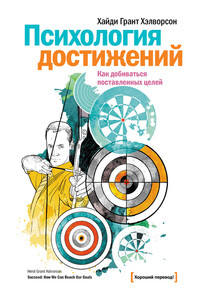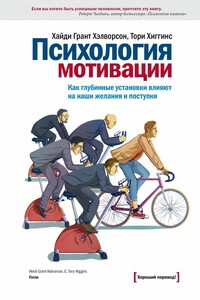Меня никто не понимает! Почему люди воспринимают нас не так, как нам хочется, и что с этим делать [заметки]
1
CEO (Chief Executive Officer) – высшая исполнительная должность в компании. В принятой в России иерархии аналог генерального директора. Прим. ред.
2
P. Baker and T. Gabriel, “With Biden Up Next to Debate, Obama’s Aides Plot Comeback”, New York Times, October 7, 2012; and A. Nagourney, A. Parker, J. Rutenberg, and J. Zeleny, “How a Race in the Balance Went to Obama”, New York Times, November 7, 2012.
3
Уиллард Ромни – американский политик. Кандидат в президенты США на выборах 2012 года от Республиканской партии. Прим. ред.
4
J. Alter, “Obama’s Choke Revisited: What His First Debate Tells Us About His Troubled Second Term”, New Republic, May 29, 2013, www.newrepublic.com/article/113287/obamas-denver-debate-choke-inside-debate-prep.
5
J. D. Vorauer and S. Claude, “Perceived Versus Actual Transparency of Goals in Negotiation”, Personality and Social Psychology Bulletin 24, no. 4 (1998): 371–385.
6
D. C. Funder, ed., Personality Judgment: A Realistic Approach to Person Perception (Waltham, MA: Academic Press, 1999).
7
L. J. Human and J. C. Biesanz, “Targeting the Good Target: An Integrative Review of the Characteristics and Consequences of Being Accurately Perceived”, Personality and Social Psychology Review 17, no. 3 (2013): 248–272.
8
Лига плюща – ассоциация восьми частных американских университетов, расположенных в семи штатах на северо-востоке США. Это название происходит от побегов плюща, обвивающих старые здания в этих университетах. Считается, что члены лиги отличаются высоким качеством образования. Прим. ред.
9
D. Leising, O. Ostrovski, and J. Zimmermann, “‘Are We Talking About the Same Person Here?’ Interrater Agreement in Judgments of Personality Varies Dramatically with How Much the Perceivers Like the Targets”, Social Psychological and Personality Science 40 (2012).
10
F. J. Bernieri, M. Zuckerman, R. Koestner, and R. Rosenthal, “Measuring Person Perception Accuracy: Another Look at Self-Other Agreement”, Personality and Social Psychology Bulletin 20, no. 4 (1994): 367–378.
11
F. D. Fincham, S. R. Beach, and D. H. Baucom, “Attribution Processes in Distressed and Nondistressed Couples: IV. Self – Partner Attribution Differences”, Journal of Personality and Social Psychology 52, no. 4 (1987): 739.
12
Эбенезер Скрудж – персонаж повести Чарльза Диккенса «Рождественская песнь», а также многочисленных фильмов. Один из самых больших скряг в истории мировой литературы. Прим. ред.
14
E. Jones et al., “Pattern of Performance and Ability Attribution: An Unexpected Primacy Effect”, Journal of Personality and Social Psychology 10, no. 4. (1968): 317–340.
15
A. Zebrowitz and S. M. McDonald, “The Impact of Litigants’ Baby-Facedness and Attractiveness on Adjudications in Small Claims Courts”, Law and Human Behavior 15, no. 6 (1991): 603–623.
16
R. J. Sternberg, “A Systems Model of Leadership: WICS”, American Psychologist 62, no. 1 (2007): 34.
17
J. S. Mueller, J. A. Goncalo, and D. Kamdar, “Recognizing Creative Leadership: Can Creative Idea Expression Negatively Relate to Perceptions of Leadership Potential?” Journal of Experimental Social Psychology 47, no. 2 (2011): 494–498.
18
Аналог российской 4 по пятибалльной шкале. Прим. ред.
19
Аналог российской 3+ по пятибалльной шкале. Прим. ред.
20
A. R. Pratkanis, “The Attitude Heuristic and Selective Fact Identification”, British Journal of Social Psychology 27, no. 3 (1988): 257–263.
21
L. Ross, “The False Consensus Effect: An Egocentric Bias in Social Perception and Attribution Processes”, Journal of Experimental Social Psychology 13, no. 3 (1977): 279–301.
22
C. Heath, “On the Social Psychology of Agency Relationships: Lay Theories of Motivation Overemphasize Extrinsic Incentives”, Organizational Behavior and Human Decision Processes 78, no. 1 (1999): 25–62.
23
R. Rosenblatt, “The 11th Commandment”, Family Circle, December 21, 1993: 30–32.
24
K. Montee, “Astaire: He Danced His Way into Our Hearts”, Fort Lauderdale (FL) Sun-Sentinel, June 23, 1987.
25
Гилберт Д. Спотыкаясь о счастье. – М.: Альпина Паблишер, 2015.
26
D. T. Gilbert, “Ordinary Personology”, The Handbook of Social Psychology 2 (1998): 89–150.
27
D. T. Gilbert, B. W. Pelham, and D. S. Krull, “On Cognitive Business: When Person Perceivers Meet Persons Perceived”, Journal of Personality and Social Psychology 54, no. 5 (1988): 733.
28
Канеман Д. Думай медленно… Решай быстро. – М.: АСТ, 2016.
29
D. T. Gilbert, “Ordinary Personology”, in Handbook of Social Psychology, vol. 2, eds. S. T. Fiske, D. T. Gilbert, and G. Lindzey (New York: McGraw-Hill, 1998), 97.
30
E. E. Jones and V. A. Harris, “The Attribution of Attitudes”, Journal of Experimental Social Psychology 3, no. 1 (1967): 1–24.
31
M. Bertrand and S. Mullainathan, “Are Emily and Greg More Employable Than Lakisha and Jamal? A Field Experiment on Labor Market Discrimination” (working paper no. 9873, National Bureau of Economic Research, 2003).
32
NASDAQ (National Association of Securities Dealers Automated Quotation – Автоматизированные котировки Национальной ассоциации дилеров по ценным бумагам) – американская биржа, специализирующаяся на акциях высокотехнологичных компаний (производство электроники, программного обеспечения и т. п.). Прим. ред.
33
J. Creswell and L. Thomas Jr., “The Talented Mr. Madoff”, New York Times, January 24, 2009.
34
Как правило, научные работы ужасны и почти всегда скучны (по крайней мере, авторы не используют юмор умышленно). Дэн Гилберт – исключение, которое подтверждает правило. Его глава по обычной персонологии в «Справочнике по социальной психологии» (Handbook of Social Psychology) носит комплексный характер, она глубокая и веселая. Если вы хотите узнать об этом подробнее, см. Handbook of Social Psychology, vol. 2, ed. S. T. Fiske, D. T. Gilbert, and G. Lindzey (New York: McGraw-Hill, 1998).
35
G. V. Bodenhausen, “Stereotypes as Judgmental Heuristics: Evidence of Circadian Variations in Discrimination”, Psychological Science 1, no. 5 (1990): 319–322.
36
P. G. Devine, “Stereotypes and Prejudice: Their Automatic and Controlled Components”, Journal of Personality and Social Psychology 56, no. 1 (1989): 5.
37
CNN, “Transcript: Bush, Putin News Conference”, CNN.com, June 18, 2001.
38
G. Casimir, K. Lee, and M. Loon, “Affective Commitment and Knowledge Sharing: Influence of Trust and the Perceived Cost of Knowledge Sharing”, Journal of Knowledge Management 16, no. 5 (2012): 740–753.
39
R. D. Costigan et al., “Revisiting the Relationship of Supervisor Trust and CEO Trust to Turnover Intentions”, Journal of World Business 46, no. 1 (2011): 74–83.
40
J. Guinot, R. Chiva, and V. Roca-Puig, “Interpersonal Trust, Stress, and Satisfaction at Work: An Empirical Study”, Personnel Review 43 (2014).
41
C. Crossley, C. Cooper, and T. Wernsing, “Making Things Happen through Challenging Goals: Leader Proactivity, Trust, and Business Unit Performance”, Journal of Applied Psychology 98, no. 3 (2013): 540–549.
42
S. T. Fiske, A. J. Cuddy, and P. Glick, “Universal Dimensions of Social Cognition: Warmth and Competence”, Trends in Cognitive Sciences 11, no. 2 (2007): 77–83.
43
A. J. Cuddy, M. Kohut, and J. Neffinger, “Connect, Then Lead”, Harvard Business Review 91, no. 7 (2013): 54–61.
44
D. S. Holoien and S. T. Fiske, “Downplaying Positive Impressions: Compensation Between Warmth and Competence in Impression Management”, Journal of Experimental Social Psychology 49 (2013): 33–41.
45
R. Gifford, “A Lens-Mapping Framework for Understanding the Encoding and Decoding of Interpersonal Dispositions in Nonverbal Behavior”, Journal of Personality and Social Psychology 66, no. 2 (1994): 398–412.
46
A. W. Brooks, H. Dai, and M. E. Schweitzer, “I’m Sorry About the Rain! Superfluous Apologies Demonstrate Empathic Concern and Increase Trust”, Social Psychological and Personality Science 5, no. 4 (2013): 467–474.
47
B. C. Gunia, J. M. Brett, and A. Nandkeolyar, “Trust Me, I’m a Negotiator: Using Cultural Universals to Negotiate Effectively, Globally”, Organizational Dynamics 43 (2014): 27–36.
48
N. A. Murphy, “Appearing Smart: The Impression Management of Intelligence, Person Perception Accuracy, and Behavior in Social Interaction”, Personality and Social Psychology Bulletin 33, no. 3 (2007): 325–339.
49
F. Righetti and C. Finkenauer, “If You Are Able to Control Yourself, I Will Trust You: The Role of Perceived Self-control in Interpersonal Trust”, Journal of Personality and Social Psychology 100, no. 5 (2011): 874.
50
F. Righetti and C. Finkenauer, “If You Are Able to Control Yourself, I Will Trust You: The Role of Perceived Self-control in Interpersonal Trust”, Journal of Personality and Social Psychology 100, no. 5 (2011): 874.
51
T. Chamorro-Premuzic and A. Furnham, Personality and Intellectual Competence (East Sussex, UK: Psychology Press, 2014).
52
Коллинз Дж. От хорошего к великому. Почему одни компании совершают прорыв, а другие нет… – М.: Манн, Иванов и Фербер, 2016.
53
Коллинз Дж. Построенные навечно. Успех компаний, обладающих видением. – М.: Манн, Иванов и Фербер, 2014.
54
A. J. Cuddy, C. A. Wilmuth, and D. R. Carney, “The Benefit of Power Posing Before a High-Stakes Social Evaluation” (working paper, Harvard Business School, Boston, 2012).
55
Z. L. Tormala, J. S. Jayson, and M. I. Norton, “The Preference for Potential”, Journal of Personality and Social Psychology 103, no. 4 (2012): 567.
56
Holoien and Fiske, “Downplaying Positive Impressions”.
57
A. J. Cuddy, Susan T. Fiske, and P. Glick, “Warmth and Competence as Universal Dimensions of Social Perception: The Stereotype Content Model and the BIAS Map”, in Advances in Experimental Social Psychology, vol. 40, ed. M. P. Zanna (New York: Academic Press, 2008), 61–149.
58
C. M. Judd, L. James-Hawkins, V. Yzerbyt, and Y. Kashima, “Fundamental Dimensions of Social Judgment: Understanding the Relations Between Judgments of Competence and Warmth”, Journal of Personality and Social Psychology 89 (2005): 899–913.
59
D. Adams, Dirk Gently’s Holistic Detective Agency (New York: Simon & Schuster, 1987).
60
J. C. Magee and P. K. Smith, “The Social Distance Theory of Power”, Personality and Social Psychology Review 17, no. 2 (2013): 158–186.
61
C. Anderson and A. D. Galinsky, “Power, Optimism, and Risk Taking”, European Journal of Social Psychology 36, no. 4 (2006): 511–536.
62
P. K. Piff et al., “Higher Social Class Predicts Increased Unethical Behavior”, Proceedings of the National Academy of Sciences 109, no. 11 (2012): 4086–4091.
63
J. Hogeveen, M. Inzlicht, and S. S. Obhi, “Power Changes How the Brain Responds to Others”, Journal of Experimental Psychology: General 143, no. 2 (2014): 755–762.
64
S. A. Goodwin et al., “Power Can Bias Impression Processes: Stereotyping Subordinates by Default and by Design”, Group Processes and Intergroup Relations 3, no. 3 (2000): 227–256.
65
S. A. Goodwin et al., “Power Can Bias Impression Processes: Stereotyping Subordinates by Default and by Design”, Group Processes and Intergroup Relations 3, no. 3 (2000): 227–256.
66
R. Rodríguez-Bailоn, M. Moya, and V. Yzerbyt, “Cuando el poder ostentado es inmerecido: sus efectos sobre la percepciоn y los juicios sociales” [When power is undeserved: its effects on perception and social judgments], Psicothema 18, no. 2 (2006): 194–199.
67
J. R. Overbeck and B. Park, “Powerful Perceivers, Powerless Objects: Flexibility of Powerholders’ Social Attention”, Organizational Behavior and Human Decision Processes 99, no. 2 (2006): 227–243.
68
M. Agthe, M. Spörrle, and J. K. Maner, “Does Being Attractive Always Help? Positive and Negative Effects of Attractiveness on Social Decision Making”, Personality and Social Psychology Bulletin 37, no. 8 (2011): 1042–1054.
69
M. Agthe, M. Spörrle, and J. K. Maner, “Does Being Attractive Always Help? Positive and Negative Effects of Attractiveness on Social Decision Making”, Personality and Social Psychology Bulletin 37, no. 8 (2011): 1042–1054.
70
N. D. Weinstein, “Unrealistic Optimism About Susceptibility to Health Problems”, Journal of Behavioral Medicine 5, no. 4 (1982): 441–460.
71
Д. Майерс. Социальная психология. – СПб.: Питер, 2016.
72
A. Tesser, M. Millar, and J. Moore, “Some Affective Consequences of Social Comparison and Reflection Processes: The Pain and Pleasure of Being Close”, Journal of Personality and Social Psychology 54, no. 1 (1988): 49.
73
M. Hewstone, M. Rubin, and H. Willis, “Intergroup Bias”, Annual Review of Psychology 53, no. 1 (2002): 575–604.
74
S. Fein and S. J. Spencer, “Prejudice as Self-Image Maintenance: Affirming the Self through Derogating Others”, Journal of Personality and Social Psychology 73, no. 1 (1997): 31.
75
Чалдини Р., Мартин С., Гольдштейн Н. Психология убеждения. 50 доказанных способов быть убедительным. – М.: Манн, Иванов и Фербер, 2013.
76
R. B. Cialdini and K. D. Richardson, “Two Indirect Tactics of Image Management: Basking and Blasting”, Journal of Personality and Social Psychology 39, no. 3 (1980): 406.
77
Ari Emanuel, quoted in E. Bumiller, “The Brothers Emanuel”, New York Times, June 15, 1997.
78
Квотербек – позиция игрока команды нападения в американском и канадском футболе. Прим. ред.
79
H. Tajfel and J. C. Turner, “The Social Identity Theory of Intergroup Behavior”, in Political Psychology: Key Readings, eds. J. T. Jost and J. Sidanius (New York: Psychology Press, 2004).
80
H. Tajfel, “Social Psychology of Intergroup Relations”, Annual Review of Psychology 33, no. 1 (1982): 1–39.
81
E. T. Higgins, “Promotion and Prevention: Regulatory Focus as a Motivational Principle”, Advances in Experimental Social Psychology 30 (1998): 1–46.
82
Х. Г. Хэлворсон, Т. Хиггинс. Психология мотивации. Как глубинные установки влияют на наши желания и поступки. – М.: Манн, Иванов и Фербер, 2014.
83
P. B. Baltes, U. M. Staudinger, and U. Lindenberger, “Lifespan Psychology: Theory and Application to Intellectual Functioning”, Annual Review of Psychology 50, no. 1 (1999): 471–507.
84
E. N. Higgins, J. Shah and R. Friedman, “Emotional Response to Goal Attainment: Strength of Regulatory Focus as Moderator”, Journal of Personality and Social Psychology 72, no. 3 (1997): 515.
85
D. Van Dijk and A. N. Kluger, “Feedback Sign Effect on Motivation: Is It Moderated by Regulatory Focus?” Applied Psychology 53, no. 1 (2004): 113–135.
86
H. Plessner et al., “Regulatory Fit as a Determinant of Sport Performance: How to Succeed in a Soccer Penalty-Shooting”, Psychology of Sport and Exercise 10, no. 1 (2009): 108–115.
87
H. Plessner et al., “Regulatory Fit as a Determinant of Sport Performance: How to Succeed in a Soccer Penalty-Shooting”, Psychology of Sport and Exercise 10, no. 1 (2009): 108–115.
88
Спок – персонаж научно-фантастического телесериала «Звездный путь» (Star Trek), известный своей безэмоциональностью и рассудительностью. Прим. ред.
89
V. K. Bohns et al., “Opposites Fit: Regulatory Focus Complementarity and Relationship Well-Being”, Social Cognition 31, no. 1 (2013): 1–14.
90
J. Cesario, H. Grant, and E. T. Higgins, “Regulatory Fit and Persuasion: Transfer from ‘Feeling Right’”, Journal of Personality and Social Psychology 86, no. 3 (2004): 388.
91
J. Bowlby, A Secure Base: Parent-Child Attachment and Healthy Human Development (New York: Basic Books, 1988).
92
C. Hazan and P. Shaver, “Romantic Love Conceptualized as an Attachment Process”, Journal of Personality and Social Psychology 52, no. 3 (1987): 511.
93
K. Bartholomew and P. R. Shaver, “Methods of Assessing Adult Attachment”, in Attachment Theory and Close Relationships, ed. J. A. Simpson and W. S. Rholes (New York: Guilford, 1998), 25–45.
94
Hazan and Shaver, “Romantic Love Conceptualized as an Attachment Process”.
95
Bartholomew and Shaver, “Methods of Assessing Adult Attachment”.
96
S. R. Levy, O. Ayduk, and G. Downey, “The Role of Rejection Sensitivity in People’s Relationships with Significant Others and Valued Social Groups”, in Interpersonal Rejection, ed. M. R. Leary (New York: Oxford University Press, 2001): 251.
97
G. Downey and S. I. Feldman, “Implications of Rejection Sensitivity for Intimate Relationships”, Journal of Personality and Social Psychology 70, no. 6 (1996): 1327.
98
Bartholomew and Shaver, “Methods of Assessing Adult Attachment”.
99
G. B. Moskowitz and P. Li, “Egalitarian Goals Trigger Stereotype Inhibition: A Proactive Form of Stereotype Control”, Journal of Experimental Social Psychology 47, no. 1 (2011): 103–116.
100
G. B. Moskowitz, P. Li, C. Ignarri, and J. Stone, “Compensatory Cognition Associated with Egalitarian Goals”, Journal of Experimental Social Psychology 47, no. 2 (2011): 365–370.
101
J. M. Burger and D. F. Caldwell, “The Effects of Monetary Incentives and Labeling on the Foot-in-the-Door Effect: Evidence for a Self-Perception Process”, Basic and Applied Social Psychology 25, no. 3 (2003): 235–241.
102
Moskowitz, Li, Ignarri, and Stone, “Compensatory Cognition”.
103
G. Keinan, “The Effects of Stress and Desire for Control on Superstitious Behavior”, Personality and Social Psychology Bulletin 28, no. 1 (2002): 102–108.
104
L. Hildebrand-Saints and G. Weary, “Depression and Social Information Gathering”, Personality and Social Psychology Bulletin 15, no. 2 (1989): 150–160.
105
W. B. Swann, B. Stephenson, and T. S. Pittman, “Curiosity and Control: On the Determinants of the Search for Social Knowledge”, Journal of Personality and Social Psychology 40, no. 4 (1981): 635.
106
S. C. Thompson and M. M. Schlehofer, “The Many Sides of Control Motivation”, in Handbook of Motivation Science, eds. James Y. Shah and Wendi L. Gardner (New York: Guilford Press, 2008): 41.
107
R. Fehr, M. J. Gelfand, and M. Nag, “The Road to Forgiveness: A Meta-analytic Synthesis of Its Situational and Dispositional Correlates”, Psychological Bulletin 136, no. 5 (2010): 894.
108
Хэлворсон Х. Г. Психология достижений. Как добиваться поставленных целей. – М.: Манн, Иванов и Фербер, 2013.
109
Дуэк К. Гибкое сознание. Новый взгляд на психологию развития взрослых и детей. – М.: Манн, Иванов и Фербер, 2013.

Прочитав эту книгу, вы узнаете, почему одним удается достигать выдающихся целей, а другим – нет. В ней содержатся тесты и практические упражнения, результаты которых помогут вам ответить на многие вопросы, связанные с причинами неудач. В специальных подглавах «Что вы можете сделать» предлагаются практические советы и рекомендации.Эта книга для всех, кто готов меняться, чтобы добиться поставленных целей и улучшить свою жизнь.

Согласно исследованиям Хайди Грант Хэлворсон и Тори Хиггинса, специалистов из Центра изучения мотивации при бизнес-школе Колумбийского университета, преобладание одной из двух мотивационных установок лежит в основе всей нашей деятельности: от работы до воспитания детей. Мотивация на получение удовольствий заставляет нас стремиться вперед и не упускать возможности, а если вами движет желание избегать боли, вы, наоборот, предпочитаете оставить все как есть и минимизировать ошибки. Книга написана простым языком, и после прочтения вы сможете понимать скрытые причины своих и чужих поступков и улучшить коммуникации.

В книге Ирис Юханссон мир ребенка-аутиста описан «изнутри», на собственном опыте. Однако этим уникальность истории Ирис не ограничивается. Это еще и история необыкновенного родительского опыта: отец Ирис, шведский крестьянин, без чьей-либо профессиональной помощи понял проблемы своей дочери. Благодаря его любви, вниманию и отзывчивости Ирис, бывшая ребенком с «глубокими нарушениями общения», сумела их преодолеть. Она стала психологом, консультирующим педагогов и родителей. Книга адресована широкому кругу читателей.

«Слова, которые исцеляют» (1975) – одна из самых известных книг Мари Кардиналь – написана на основе ее собственного опыта в психоанализе. Изображен тот период и те условия, что привели автора к психической нестабильности, а затем к постепенному выздоровлению. Сюжет вращается вокруг женщины, переживающей эмоциональный срыв, порожденный ее отношениями с матерью. Героиня проходит длительный курс психоанализа. Постепенно она понимает, что была не в состоянии справиться с жесткими рамками кодекса поведения патриархальной системы, регулирующими ее жизнь с детства.

В своей книге я написала все свои препятствия, страхи на пути к выздоровлению. Я уверена, что каждый из вас найдет именно в ней именно то, что в данный момент нужно. Между строк можно увидеть себя и провести параллель, даже если у вас вопрос, проблема, связаны не со здоровьем, как у меня. Мне будет приятно услышать от вас лично, чем была полезна моя книга. Для меня это важно, ведь творчество мое не имеет границ и готова написать вам следующую книгу, которая будет так же вам полезна, как и эта.

Человек есть по замыслу Бога существо богоподобное, и потому его нормальная жизнь возможна не иначе, как в общении с Богом, чтобы достигнуть своего истинного назначения и вечного блаженства. История грехопадения Адама и Евы повлияла на все последующее развитие человечества. Принципиальное значение грехопадения наших прародителей заключалось прежде всего в том, что человек перенес центр своей жизни и деятельности с Бога на самого себя. Созданный Богом человек сознательно и свободно решился вместо воли Божией поставить свою волю началом своей жизнедеятельности, самого себя и свою самость сделать центром существующего мира и целью своей жизни.

Раскрываются причины уникального явления общества, характерного для всех цивилизованных стран, — малой продолжительности жизни врачей, среднее значение которой на 15–20 лет ниже жизни их пациентов. Показано, что среди причин имеются такие необычные, как высокая чувствительность и культ смерти. Представлены теория Любви, Разума и Жизни, а также теория Смысла Жизни и теория преждевременной старости. Формулируются положения духовной психологии. Предложен авторский взгляд на концепцию Человека, болезни и здоровья.
